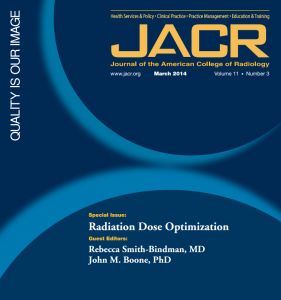JACR Special Issue: Radiation Dose Optimization
 Last month, the Journal of the American College of Radiology released a special issue entitled Radiation Dose Optimization, inspired by the UCSF Virtual Symposium that went live last May and has been available on demand since then. I am honored to have been invited to be the guest editor along with UC Davis’ John M. Boone, PhD. This issue of the JACR highlights the important topics in radiation safety and dose optimization, written by experts in the field of radiology. The topics cover radiation dose from the perspective of physicians, patients, and payers including how to communicate with patients about radiation dose; cover specific and concrete strategies for dose optimization; and how to measure dose for quality improvement.
Last month, the Journal of the American College of Radiology released a special issue entitled Radiation Dose Optimization, inspired by the UCSF Virtual Symposium that went live last May and has been available on demand since then. I am honored to have been invited to be the guest editor along with UC Davis’ John M. Boone, PhD. This issue of the JACR highlights the important topics in radiation safety and dose optimization, written by experts in the field of radiology. The topics cover radiation dose from the perspective of physicians, patients, and payers including how to communicate with patients about radiation dose; cover specific and concrete strategies for dose optimization; and how to measure dose for quality improvement.
The advances in medical imaging technology over the past 30 years have transformed medical care and led to more rapid and accurate diagnoses. As a result, we’ve seen an improvement in patient outcomes and an increase in simple, noninvasive cross-sectional imaging. But, with increased access to these medical imaging exams, there’s been a profound rise in their use and reduced threshold for ordering them which has led to overuse.
CT has become a major workhorse of diagnostic medicine, but it is a procedure that uses higher levels of ionizing radiation than other x-ray modalities, and x-rays are known to be a carcinogen. If a CT scan is clearly indicated and well ordered, the benefit-to-risk ratio is high. However, if a CT scan is not medically necessary or if it could easily be replaced with a test that does not use ionization radiation, the benefit-to-risk ratio is low.
Unfortunately, meaningful progress toward dose reduction has been slow, and there remain relatively few well-defined standards for how CT examinations should be conducted. While dose optimization is a priority at UCSF, and our dose metrics reflect this priority, this is not the case at all institutions and should be. One of the main messages we tried to communicate in this special issue is that for meaningful change to occur, collaboration amongst a diverse team of key players including radiologists, physicists and technologists is necessary to move forward. This special issue of JACR is focused on CT dose and dose reduction. It includes expert commentary on radiology for pediatric patients, the benefit of virtual meetings (like our Virtual Symposium on Radiation Safety in Computed Technology), health care reform, future advances, and more!
For easy access, we’ve listed articles co-authored by UCSF staff and faculty from this special edition! Please find them here:
- Virtual Meetings: Improving Impact and Accessibility of CME, page 231
- Health Care Reform and Its Impact on Radiology Practice, page 252
- CTSim: An Interactive Computer Simulation to Learn the Fundamentals of CT Dose Optimization, page 255
- Techniques and Tactics for Optimizing CT Dose in Adults and Children: State of the Art and Future Advances, page 262
- Standardization and Optimization of CT Protocols to Achieve Low Dose, page 272
- Personalized Technologist Dose Audit Feedback for Reducing Patient Radiation Exposure From CT, page 300
- Radiation Dose Metrics in CT: Assessing Dose Using the National Quality Forum CT Patient Safety Measure, page 309
To access the full JACR Special Issue: Radiation Dose Optimization, please click here.
